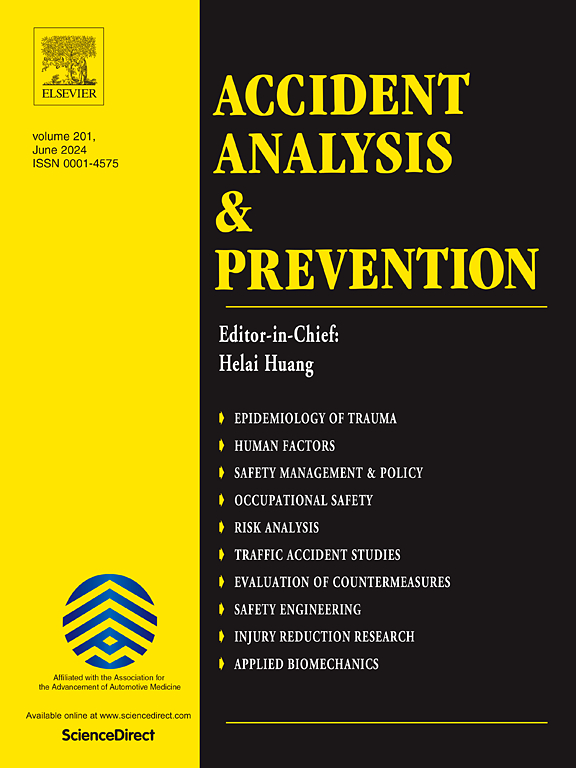Safety effectiveness of forward collision warning systems in the vehicle fleet: A driving simulation study
IF 6.2
1区 工程技术
Q1 ERGONOMICS
引用次数: 0
Abstract
The increasing rate of crashes globally has prompted the development of strategies like the Advanced Driver Assistance systems (ADAS) to improve safety. These systems range from subtle speed adjustment alerts to automatic emergency braking. One such system is the forward collision warning (FCW), which aims to mitigate collisions, particularly rear-end crashes, by providing visual, auditory, or tactile alerts of impending collisions. However, there has not been enough attention given to how drivers might react to FCW without unintentionally distracting them, while also using serious conflicts to quantify safety. This driving simulation study aimed to assess the effectiveness of the FCW by examining serious conflict as a surrogate measure for actual crashes. The goal was to estimate a Crash Modification Factor (CMF) for FCW systems within vehicle fleet, considering varying market penetration rates ranging from 10 percent to 50 percent in increments of 10 percent. Scenarios were created where drivers encountered different road and traffic conditions to evaluate their responses to unexpected events. A total of 133 participants completed a between subject design in which half of them drove the course with the FCW programmed into the simulation, and the other half did not have the FCW. The evaluation of serious conflicts utilized the Swedish Traffic Conflict Technique, employing two key indicators: Time to Accident (TA) and Conflicting Speed. Conflict severity was measured by considering two variables − the lane position and speed of the participants which was used to compute the TA. As expected, drivers in each scenario experienced fewer serious conflicts when assisted by FCW systems compared to the drivers without them. The resulting CMFs from the study can be integrated into crash prediction models to support efforts to keep crash prediction models up to date by accounting for the effects of increasing numbers of vehicles having FCW systems.
车辆前方碰撞预警系统的安全有效性:驾驶模拟研究
全球撞车率的不断上升促使了先进驾驶辅助系统(ADAS)等策略的发展,以提高安全性。这些系统的范围从细微的速度调整警报到自动紧急制动。前方碰撞预警系统(FCW)就是这样一个系统,它旨在通过提供即将发生碰撞的视觉、听觉或触觉警报来减轻碰撞,尤其是追尾碰撞。然而,对于驾驶员如何在不无意中分散注意力的情况下对FCW做出反应,以及如何利用严重的冲突来量化安全性,人们还没有给予足够的重视。本驾驶模拟研究旨在通过检查严重冲突作为实际碰撞的替代措施来评估FCW的有效性。考虑到市场渗透率从10%到50%不等,以10%为增量,目标是估计车辆中FCW系统的碰撞修正系数(CMF)。研究人员创建了驾驶员遇到不同道路和交通状况的场景,以评估他们对意外事件的反应。共有133名参与者完成了受试者之间的设计,其中一半人在模拟中编程了FCW,另一半人没有FCW。严重冲突的评估采用瑞典交通冲突技术,采用两个关键指标:事故发生时间(TA)和冲突速度。冲突严重程度通过考虑车道位置和参与者的速度两个变量来衡量,这两个变量用于计算TA。正如预期的那样,与没有FCW系统的司机相比,在每种情况下,有FCW系统辅助的司机经历的严重冲突都更少。研究得出的CMFs可以集成到碰撞预测模型中,通过考虑到越来越多的车辆配备FCW系统的影响,支持碰撞预测模型的更新。
本文章由计算机程序翻译,如有差异,请以英文原文为准。
求助全文
约1分钟内获得全文
求助全文
来源期刊

Accident; analysis and prevention
Multiple-
CiteScore
11.90
自引率
16.90%
发文量
264
审稿时长
48 days
期刊介绍:
Accident Analysis & Prevention provides wide coverage of the general areas relating to accidental injury and damage, including the pre-injury and immediate post-injury phases. Published papers deal with medical, legal, economic, educational, behavioral, theoretical or empirical aspects of transportation accidents, as well as with accidents at other sites. Selected topics within the scope of the Journal may include: studies of human, environmental and vehicular factors influencing the occurrence, type and severity of accidents and injury; the design, implementation and evaluation of countermeasures; biomechanics of impact and human tolerance limits to injury; modelling and statistical analysis of accident data; policy, planning and decision-making in safety.
 求助内容:
求助内容: 应助结果提醒方式:
应助结果提醒方式:


